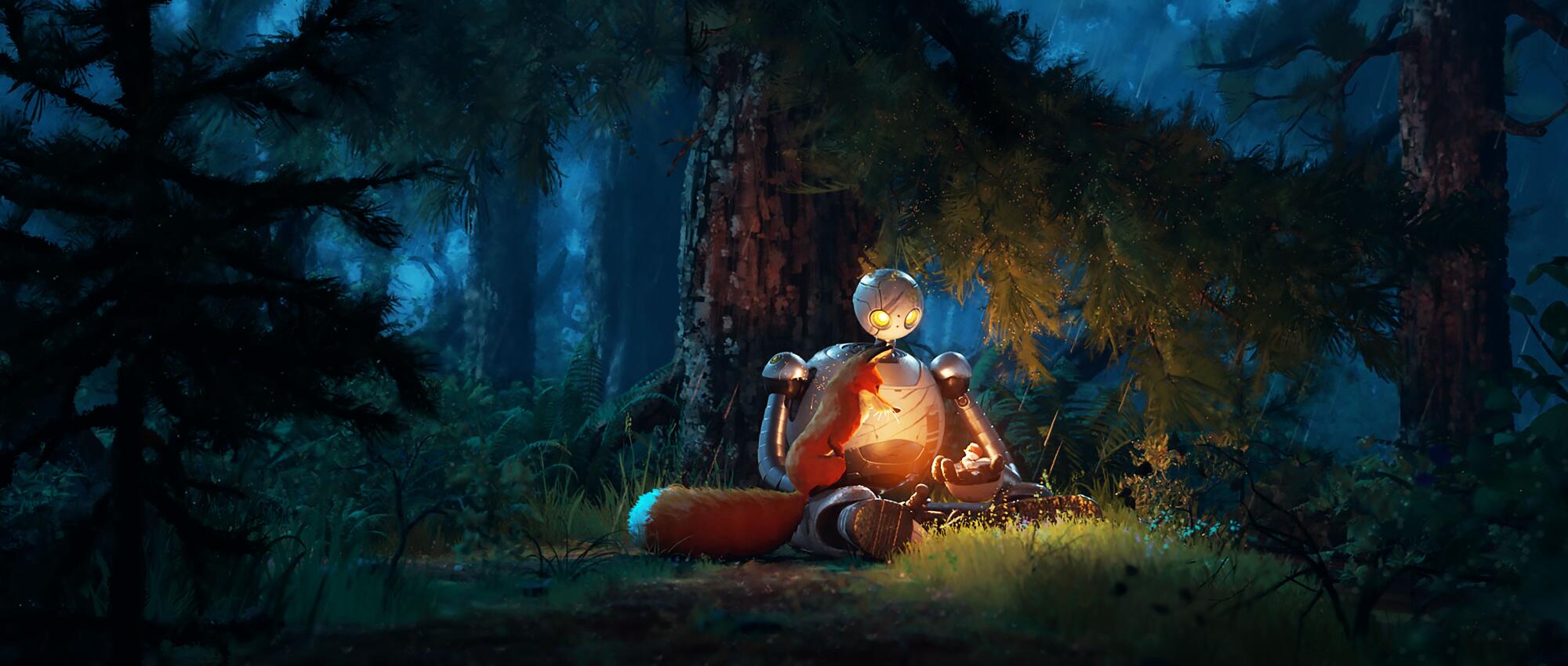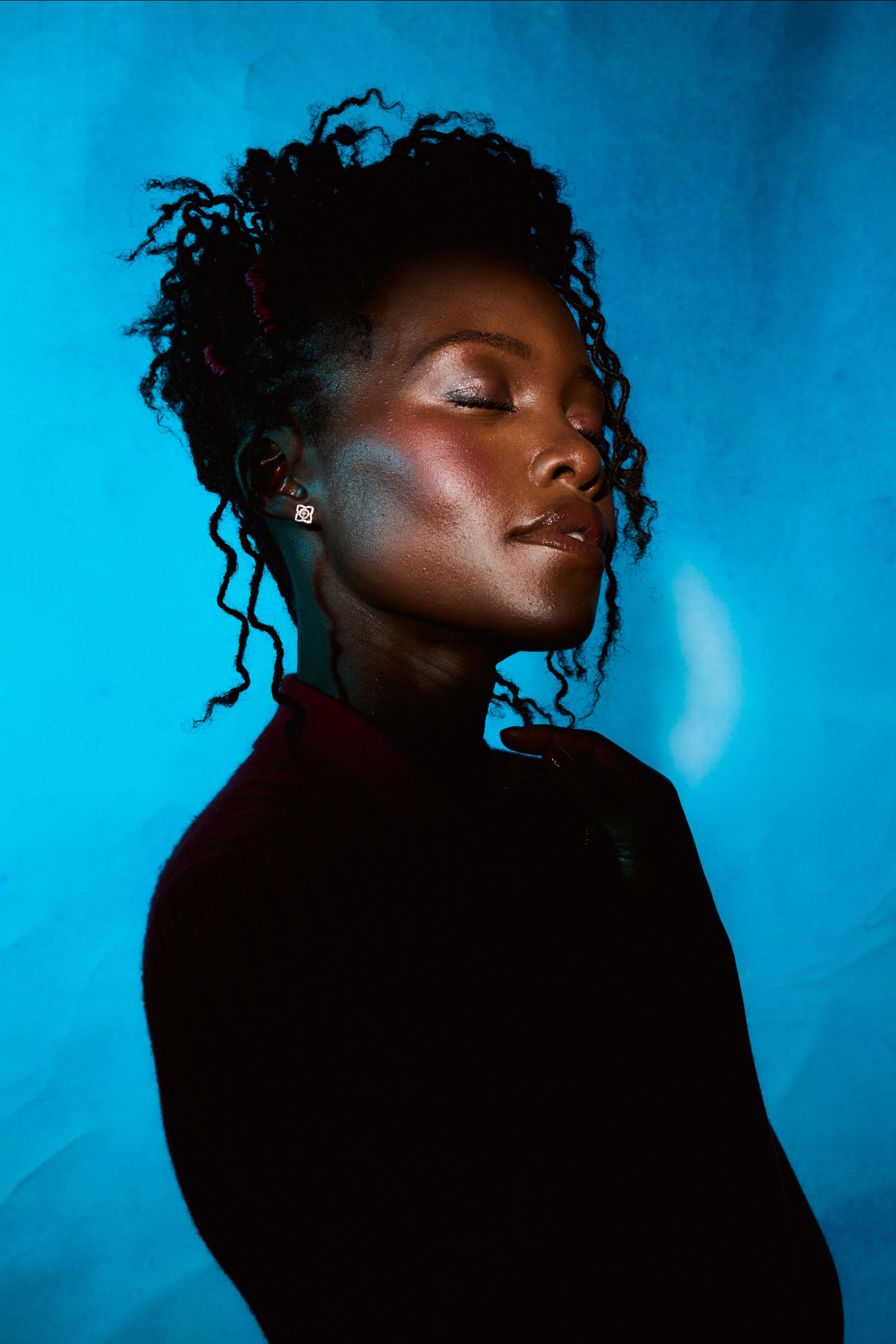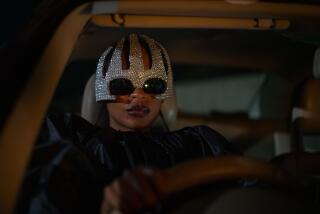
- Share via
If she could pick only one animated film to bring with her to a desert island, Lupita Nyong’o would probably choose Disney’s 1994 “The Lion King.”
“I know some of those scenes by heart,” she says, speaking on Zoom from a hotel in Santa Monica. “That’s how many times I’ve watched it. More than I can count.”
But now that the Mexico-born, Kenya-raised actor is giving voice to an animated character who actually does wash ashore on a remote island, it’s possible that Simba, Timon, Pumbaa and company may have some competition.
From director Chris Sanders, the animation veteran behind 2002’s “Lilo & Stitch,” “The Wild Robot” (in theaters Sept. 27) follows a talking humanoid robot, ROZZUM unit 7134 or “Roz” (Nyong’o), who develops a maternal bond with an orphaned gosling, Brightbill (Kit Connor), after becoming a stranger in a strange land. (In this futuristic reality, the humans seem to live elsewhere, in secluded domed cities.)

Through trial and error, Roz establishes relationships with the native animals, including a sly fox named Fink (Pedro Pascal), Pinktail (Catherine O’Hara), an overwhelmed possum mother, and Thorn (Mark Hamill), a bear who likes to be on his own. Adapted from the 2016 book by Peter Brown, the sci-fi fable suggests that even in this environment, where animals act on instinct, compassion can thrive.
When first approached for the project, the “12 Years a Slave” Oscar winner didn’t immediately sign on. “I needed to make sure that Chris was looking for a collaborator rather than an executor,” Nyong’o, 41, says.
With refreshing candor, she admits that “the thought of being a part of a project that takes so long with people you can’t stand” didn’t appeal to her. To avoid that, she carried out a “vetting process,” meeting Sanders and producer Jeff Hermann on multiple occasions with copious questions about their motivations for the film. (In 2019, Nyong’o wrote her own children’s book, “Sulwe,” which deals with colorism through the story of a girl who wishes her skin tone were lighter.)
“Lupita approached this with every bit of seriousness and thoughtfulness that she would with any other of her roles,” says Sanders by video call. “As an animation guy, I always appreciate that.”

The thematic core of “The Wild Robot” — finding harmony in an ever-divided world through curiosity and respect — resonated with the actor. “The idea that kindness could be a survival skill that allows us all to flourish in our differences is radical, beautiful and true,” says Nyong’o.
At that point, the screenplay wasn’t fully formed. Neither were the temperaments or the designs of the characters. There were only preliminary sketches as reference.
“Any time an actor actually commits, the very first thing we do is go back to the script and begin to customize it,” says Sanders. “Once we get to the recording studio, it evolves again because their creative input is going to be immediate.”
“They weren’t just there to appease me,” Nyong’o remembers. “I could feel my contributions really meshing into his vision.”
Although she had previously voiced the wise and protective Raksha, an Indian wolf in Disney’s photorealistic 2016 remake of “The Jungle Book,” Nyong’o knew “The Wild Robot” would require a deeper commitment.
“There is a different kind of responsibility to being the lead,” she says. “And I was very mindful of the fact that I had not been a part of that sort of intricate step-by-step process in animation.” (It’s been a big summer for Nyong’o, who also stepped into the main role for this summer’s hit “A Quiet Place: Day One,” her first big-scale Hollywood action lead.)

Over the course of nearly two years beginning in late 2022, Nyong’o and Sanders fine-tuned the arc of Roz’s personality as the animation itself took shape. Each recording session, she says, felt like a workshop of the script.
“We started off with what I like to call ‘programmed optimism,’ the kind of optimism you hear in voices like Siri or Alexa,” Nyong’o says of her character, moving through an unknown forest environment with a certain naivete. “And then as she adapts and begins to mimic more and more the animals around her — and as she grows into the mother she will finally be — she finds more dimension and nuance in her delivery.”
The Roz robot doesn’t have facial expressions, a deliberate design decision on Sanders’ part.
“There’s an enormous amount of empathy that you feel for a character like that,” he says, remembering being inspired by similar outwardly stoic robots, such as R2-D2, C-3PO and Robby the Robot from 1956’s “Forbidden Planet.”
It meant that Nyong’o’s voice alone would take on the burden of the emotional weight. “Everything that she is trying to transmit and evoke has to be in that voice in the recording,” Sanders says. “And that’s a huge amount of work. It’s a very subtle thing.”
“The fact that she doesn’t have expression means we get to project our emotion onto her,” Nyong’o says.
Why are humans so utterly fascinated with artificial creations like Roz?
“We’re vain and self-centered,” Nyong’o cracks, but also meaning it. “The world rotates around us, as far as we’re concerned. That’s why we anthropomorphize animals. The candelabra in ‘Beauty and the Beast’ — why does it have a face? Because we want to see ourselves in things that do not look like us, to bring ourselves closer to a better understanding of ourselves.”

“Wild Robot” articulates a complex conception of motherhood, one that’s uncommon for animated movies aimed at young audiences, which often lean into conventional representations. (France’s recent “Chicken for Linda!” is a notable exception.)
“When you are a child, you are brought into a world where you believe your mother knows everything,” she says. “But mothers are living their lives for the first time as well. They’re learning just as well as children are learning. They’re growing into mothers.” In “The Wild Robot,” Roz’s mission becomes getting Brightbill ready to migrate with a flock of his own species, a journey that also charts her own emotional development from confusion to confidence — and even a sense of humor.
Giving a full-bodied performance while standing in place, Nyong’o recalls, can prove challenging, requiring an actor to use their body in ways that they would never use it otherwise.
“There’s a scene where Roz is running, and then it occurred to me, ‘Well, if I were running, I would be out of breath, but Roz is a robot, so she wouldn’t be out of breath,’ ” Nyong’o says. “Being in the booth allowed me to experience that in a way that was truer to Roz than it would be for me.”
Sanders, who has been on the other side of the microphone playing the voice of Stitch, the beloved koala-like alien from the Disney film he directed, knows how taxing voice recording can be.
“By the end of these sessions, everybody can feel like they ran a marathon,” he says. “In one animated recording session, you might go through 10 or even 15 scenes. The emotional wavelengths you’re putting the actor through can be very broad, and that can be exhausting.”
In fact, during one of her sessions, Nyong’o injured her vocal cords, which forced her to remain silent for three months to avoid surgery for the polyp that had formed on her throat.
“It was difficult, but I learned how much I rely on talking to maintain my personality,” she says. “When I had to be quiet, I became a lot more observant and comfortable inside.”
Watching the completed movie for the first time floored her.
“I thought to myself, ‘Wow, this is one of those legitimately large-scale, sweeping, emotionally overwhelming, beautiful animations that I’ve grown up loving,’ ” she says. “The animation quality that they’ve achieved, that painterly feeling, makes it feel nostalgic and futuristic at the same time. It’s quite stunning.”
Nyong’o smiles at her own enthusiasm. “Animation gives us permission to have big feelings,” she says.
More to Read
Only good movies
Get the Indie Focus newsletter, Mark Olsen's weekly guide to the world of cinema.
You may occasionally receive promotional content from the Los Angeles Times.











